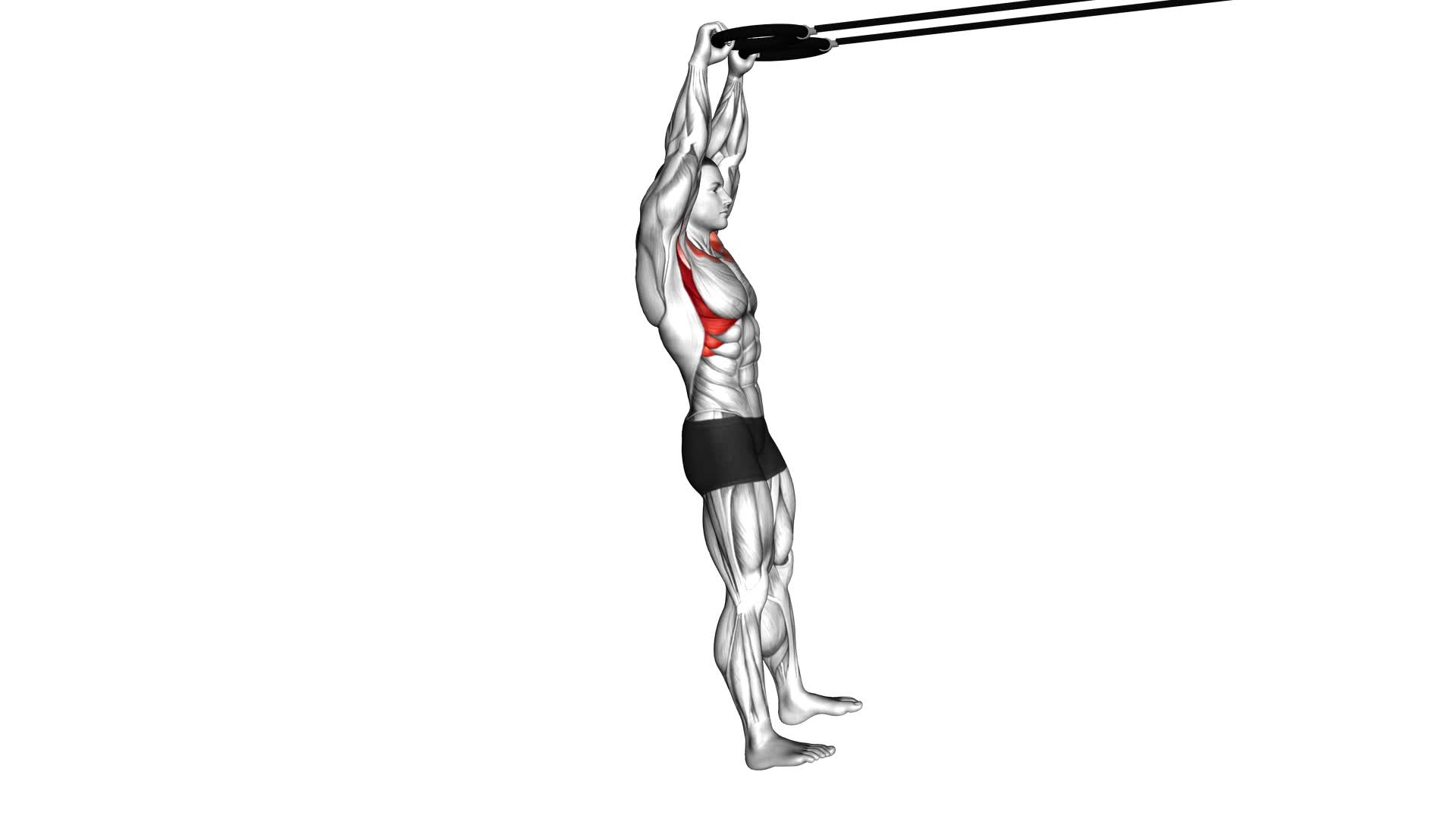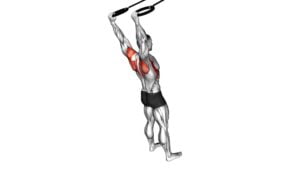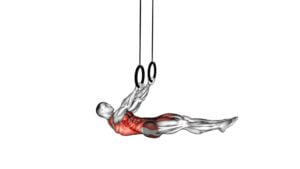Ring Front Raise (male) – Video Exercise Guide & Tips

Are you looking to build strong, defined shoulders? Get ready to level up your workout with the Ring Front Raise exercise!
Watch This Exercise Video
In this video exercise guide, we'll show you the proper form and technique to maximize your results.
Discover variations and progressions to challenge yourself and avoid common mistakes.
Whether you're a beginner or a seasoned pro, these tips will help you achieve your fitness goals.
Let's get started and take your shoulder workout to the next level!
Key Takeaways
- Ring front raise targets the anterior deltoids for improved shoulder stability and upper body strength.
- It engages core muscles for stability and balance, improving overall body strength and posture.
- Ring front raise enhances muscle tone and definition in the shoulders, improving shoulder stability and mobility.
- It engages multiple muscle groups, including the deltoids, trapezius, and triceps, making it effective for developing better posture and upper body alignment.
Benefits of the Ring Front Raise
To maximize your workout results, incorporating the Ring Front Raise into your routine offers numerous benefits. This exercise primarily targets the anterior deltoids, which are the muscles located at the front of your shoulder. By regularly performing Ring Front Raises, you can effectively strengthen and tone these muscles, leading to improved shoulder stability and overall upper body strength.
Moreover, the Ring Front Raise can be seamlessly integrated with other exercises to create a comprehensive shoulder workout. For example, you can combine it with exercises like push-ups, lateral raises, or overhead presses to engage multiple muscle groups simultaneously. This not only saves you time but also enhances the efficiency of your workouts.
Additionally, the Ring Front Raise requires you to engage your core muscles for stability and balance. This means that while primarily targeting your shoulders, you're also engaging your abs, glutes, and lower back muscles. This dual engagement makes the Ring Front Raise a highly effective compound exercise that can help you build overall body strength and improve your posture.
Proper Form and Technique
To perform the Ring Front Raise with proper form and technique, start by standing tall with your feet shoulder-width apart and a slight bend in your knees. Grab the rings with an overhand grip, palms facing down. Keep your arms straight and extended in front of you, parallel to the ground. Engage your core and maintain a neutral spine throughout the exercise.
One common error to avoid is using momentum to lift the rings. Instead, focus on using your shoulder muscles to initiate the movement. Lift the rings up until they're at shoulder height, making sure to keep your arms straight and your wrists in line with your shoulders.
Another common error is shrugging your shoulders during the raise. This can lead to unnecessary strain and tension in your neck and upper traps. To prevent this, consciously relax your shoulders and keep them down and away from your ears.
Proper muscle activation is key to maximizing the benefits of the Ring Front Raise. This exercise primarily targets the anterior deltoids, or the front of your shoulders. To ensure proper muscle activation, focus on squeezing your shoulder blades together and engaging your deltoids throughout the movement.
Now that you know the proper form and technique for the Ring Front Raise, let's move on to exploring variations and progressions to continue challenging yourself and further develop your shoulder strength and stability.
Variations and Progressions
Try incorporating different weight variations, such as using heavier rings or adding weight plates, to increase the intensity and challenge of the Ring Front Raise exercise. These progression options can help you continue to build strength and target specific muscle groups more effectively. By using heavier rings or adding weight plates to the rings, you're increasing the resistance and demanding more from your muscles. This won't only make the exercise more challenging, but it will also help you develop greater shoulder and upper body strength.
When using heavier rings, it's important to maintain proper form and technique. Make sure to engage your core, keep your shoulders down and back, and avoid any swinging or momentum. Focus on slow and controlled movements to maximize the benefits of the exercise.
In addition to using heavier rings, you can also try variations such as alternating between single-arm and double-arm raises, or performing the exercise on one leg for added stability and core engagement. These variations can help target different muscle groups and add variety to your workouts.
Now that you know about the progression options and variations for the Ring Front Raise exercise, let's move on to the next section: common mistakes to avoid.
Common Mistakes to Avoid
Avoiding common mistakes is crucial when performing the Ring Front Raise exercise. To ensure that you're performing the exercise correctly and maximizing its benefits, here are some common mistakes to avoid:
- Using improper grip: Make sure to grip the rings firmly and evenly, avoiding any uneven pressure that may cause instability.
- Raising the rings too high: It's important to maintain control throughout the movement and avoid raising the rings above shoulder level. This will help prevent strain on the shoulders and maintain proper form.
- Swinging the body: Keep your body still and avoid any swinging or momentum during the exercise. This will ensure that the targeted muscles are engaged and working effectively.
- Neglecting proper breathing technique: Remember to breathe throughout the exercise, inhaling during the lowering phase and exhaling during the raising phase. This will help maintain stability and control.
By avoiding these common mistakes and focusing on proper technique, you can perform the Ring Front Raise exercise safely and effectively.
Always listen to your body and make adjustments as needed to maintain proper form and prevent injury.
Tips for Maximizing Results
To maximize your results while performing the Ring Front Raise exercise, it's important to incorporate these tips into your routine.
One of the common misconceptions about this exercise is that it only targets the shoulders. However, it also engages the muscles in your upper back and core, making it a great overall upper body exercise.
When incorporating the Ring Front Raise into your workout routine, it's important to start with a weight that challenges you but still allows you to maintain proper form. Gradually increase the weight as you get stronger to continue challenging your muscles.
Another tip is to focus on the mind-muscle connection. Concentrate on engaging the muscles in your shoulders and upper back as you lift the rings. This will help you get the most out of each repetition.
Additionally, make sure to maintain a controlled and steady pace throughout the exercise, avoiding any swinging or jerking motions.
Lastly, don't forget to breathe properly during the exercise, inhaling as you lower the rings and exhaling as you raise them.
Frequently Asked Questions
What Are Some Alternative Exercises That Target the Same Muscle Groups as the Ring Front Raise?
Looking for alternative exercises that target the same muscle groups as the ring front raise?
There are a few options to consider. Shoulder presses, lateral raises, and front raises with dumbbells are all great choices.
These exercises work the same muscles as the ring front raise, helping to strengthen and tone your shoulders.
Incorporate a variety of these exercises into your workout routine to keep your muscles challenged and to achieve optimal results.
How Many Sets and Repetitions Should I Perform for the Ring Front Raise to See Results?
To see results with the ring front raise, it's important to consider optimal training frequency and progressive overload.
Focus on performing the exercise with proper form and gradually increase the weight or resistance over time.
Start with a manageable number of sets and repetitions, and gradually increase them as you get stronger.
Consistency is key, so aim to perform the exercise at least two to three times per week for optimal results.
Can the Ring Front Raise Be Modified for Individuals With Shoulder Injuries or Limitations?
Yes, the ring front raise can be modified to accommodate individuals with shoulder injuries or limitations. By adjusting the range of motion and resistance, you can still benefit from this exercise while avoiding further strain on your shoulders.
The ring front raise is particularly beneficial for shoulder rehabilitation as it helps strengthen the muscles surrounding the joint and improves stability.
Consult with a qualified trainer or physical therapist to ensure proper modifications for your specific needs.
Is It Necessary to Use Rings for the Ring Front Raise, or Can Dumbbells or Resistance Bands Be Used Instead?
For the ring front raise exercise, you might be wondering if you can use dumbbells or resistance bands instead of rings. While it isn't necessary to use rings, they do offer some unique benefits for upper body exercises.
Rings require more stability and engagement of your core muscles, providing a greater challenge and improving your overall strength.
However, if you have shoulder injuries or limitations, dumbbells or resistance bands might be a better option as they allow for more control and customization of the movement.
Are There Any Specific Warm-Up Exercises That Should Be Done Before Performing the Ring Front Raise?
Before performing the Ring Front Raise, it's important to do specific warm-up exercises to prepare your muscles and joints. These warm-up exercises can include arm swings, shoulder rotations, and light shoulder presses.
By warming up properly, you can reduce the risk of injury and improve your performance during the Ring Front Raise.
Additionally, the Ring Front Raise has many benefits, such as targeting the front deltoids and improving shoulder stability and strength.
Conclusion
In conclusion, the ring front raise exercise is a beneficial movement for strengthening the shoulders and upper body. By maintaining proper form and technique, you can effectively target the targeted muscles and avoid common mistakes.
Additionally, incorporating variations and progressions can help challenge your muscles and maximize results. Remember to follow these tips to get the most out of your workout and achieve your fitness goals.

Author
Years ago, the spark of my life’s passion ignited in my mind the moment I stepped into the local gym for the first time. The inaugural bead of perspiration, the initial endeavor, the very first surge of endorphins, and a sense of pride that washed over me post-workout marked the beginning of my deep-seated interest in strength sports, fitness, and sports nutrition. This very curiosity blossomed rapidly into a profound fascination, propelling me to earn a Master’s degree in Physical Education from the Academy of Physical Education in Krakow, followed by a Sports Manager diploma from the Jagiellonian University. My journey of growth led me to gain more specialized qualifications, such as being a certified personal trainer with a focus on sports dietetics, a lifeguard, and an instructor for wellness and corrective gymnastics. Theoretical knowledge paired seamlessly with practical experience, reinforcing my belief that the transformation of individuals under my guidance was also a reflection of my personal growth. This belief holds true even today. Each day, I strive to push the boundaries and explore new realms. These realms gently elevate me to greater heights. The unique combination of passion for my field and the continuous quest for growth fuels my drive to break new ground.







